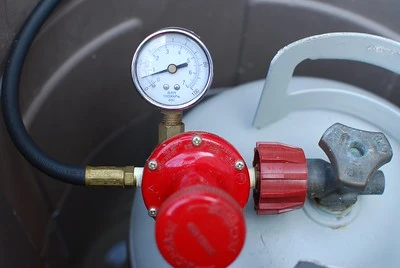
A typical propane regulator is set to deliver gas at around 10 to 11 PSI (pounds per square inch). This is the amount of pressure needed for most appliances that run on propane, like grills and heaters, to work safely and efficiently.
If the pressure is too high, it can be dangerous and cause leaks or damage to your appliances. On the other hand, if it’s too low, your appliances may not work properly or could struggle to stay lit.
That’s why a regulator is important—it keeps the propane pressure at the right level for safe and smooth operation. Most household propane regulators are preset to this standard pressure, so you usually don’t need to adjust it yourself.
However, in some cases, you may need a different regulator depending on the type of propane system you have. For example, industrial or commercial setups may require higher pressure regulators.
If you ever notice issues like weak flames, inconsistent heating, or strange smells, it could be a sign that your regulator isn’t working properly or that the pressure is off. It’s always a good idea to get it checked by a professional if you’re unsure. Regular maintenance ensures your propane system stays safe and reliable.
Read Also: Are Propane Regulators All the Same? (Are They Universal)
Why Proper PSI is Important
Having the right PSI in your propane regulator is important for a couple of reasons. If the pressure is too high, it can cause serious problems like gas leaks, which are dangerous and could lead to fires. It can also damage your appliances by pushing too much gas through them.
On the flip side, if the pressure is too low, your appliances won’t work as well. You might notice weak flames on your grill or stove, or they might not stay lit at all. This means your appliances won’t run efficiently, and it could be frustrating trying to get them to work properly. Keeping the PSI just right ensures everything runs smoothly and safely.
Maintaining the proper PSI also helps you save on propane because your appliances will be using the fuel more efficiently. When the pressure is off, your system could end up wasting gas or making your appliances work harder than they need to. This not only costs you more money but also shortens the lifespan of your equipment.
Having the right pressure also plays a big role in safety. Propane is highly flammable, so any imbalance in pressure—whether too high or too low—can create potential hazards. That’s why regulators are built to keep the PSI stable, giving you peace of mind while using propane-powered appliances.

Read Also: Are Propane Regulators Gas Specific and Are Interchangeable?
Different Types of Regulators for Different Needs
There are different types of propane regulators designed for various uses. For most homes, a standard regulator with a set PSI (usually between 10 to 11 PSI) works just fine for things like grills, heaters, and stoves. These are called preset regulators because they are already set to the correct pressure, and you don’t need to adjust them.
In other situations, like in industrial or commercial settings, the needs are different. Some equipment might require higher or lower PSI, depending on how much propane they use. This is where adjustable regulators come in. These let you manually change the pressure to match the specific needs of your equipment.
Choosing the right type of regulator depends on how you’re using propane. For most everyday tasks, a preset regulator will do the job, but if you need more control, an adjustable regulator is a better fit.
Signs Your Regulator Needs Attention
There are a few signs that your propane regulator might need some attention:
- Weak Flames: If you’re noticing that the flame on your grill, stove, or heater is smaller than usual, it could be a sign that the regulator isn’t letting enough gas through. This means your appliances aren’t getting the proper amount of fuel to work at full strength.
- Inconsistent Heat: If the heat from your appliance keeps going up and down without you adjusting it, that’s another clue something might be wrong with the regulator. It could mean the pressure isn’t steady, making your appliance perform unpredictably.
- Unusual Smells: If you smell gas when you shouldn’t, it could be a sign of a leak, which may happen if the regulator is letting too much gas through. Propane has a strong, distinctive smell (like rotten eggs) that’s easy to notice. A gas leak is serious, and you should stop using the appliance immediately if you smell propane.
Read Also: What Kind of Regulator Do I Need for My Propane Tank? (Factors)
When to Get a Professional Involved
If you notice any of these signs, it’s a good idea to have a professional check your system. They can test the regulator, make sure it’s working properly, and fix any issues before they become dangerous. Regular maintenance by a professional can also help prevent these problems from happening in the first place. It’s always better to be safe when dealing with propane.
Some Common Questions
- What pressure is an LPG regulator?
- An LPG (liquefied petroleum gas) regulator typically delivers gas at a pressure of around 10 to 11 PSI for household use. This ensures a steady, safe flow of gas to appliances like stoves and heaters.
- How many PSI is a home propane system?
- Most home propane systems are designed to operate at around 10 to 11 PSI. This pressure is controlled by the propane regulator, which ensures that your appliances get the right amount of gas for safe operation.
- What pressure would a propane service regulator normally deliver?
- A standard propane service regulator usually delivers gas at 10 to 11 PSI, which is the ideal pressure for most household appliances. Commercial or industrial systems may require different settings, depending on their needs.
- What is the pressure of LPG gas?
- The pressure of LPG gas in its liquid state (inside the tank) can vary based on the temperature but is typically between 100 to 200 PSI. When released from the tank, the regulator reduces this pressure to a much lower, usable level.
- What is the output pressure of an LPG regulator?
- The output pressure of a standard LPG regulator is around 10 to 11 PSI for household use, which is the level required for most propane appliances to operate safely and efficiently.
- How do I increase the pressure on my LPG regulator?
- Some LPG regulators are adjustable. To increase the pressure, you can turn the adjustment screw (usually located on the regulator) clockwise. However, it’s important to be cautious and consult a professional, as increasing the pressure too much can be dangerous.
- What pressure is LPG stored at PSI?
- LPG is stored in its liquid form inside tanks at a pressure that ranges from about 100 to 200 PSI, depending on the temperature. The pressure in the tank changes as the gas is used and the temperature fluctuates.
- What is a high-pressure LPG regulator?
- A high-pressure LPG regulator is designed for applications that require gas at higher pressures, such as some industrial equipment or large commercial appliances. These regulators can deliver propane at pressures well above the standard 10 to 11 PSI, sometimes up to 60 PSI or more.
- What is the PSI rating of a propane tank?
- Propane tanks are designed to safely handle pressures of around 100 to 200 PSI, depending on the temperature. The PSI inside the tank increases when it’s hot and decreases when it’s cold, but the tank is built to manage these changes safely.
To Make a Conclusion
To keep your propane appliances working safely and efficiently, having the right PSI is essential. For most household appliances, a regulator set to 10 to 11 PSI is just right. This pressure ensures that your grill, stove, or heater gets enough gas to function properly without risking leaks or damage.
Keeping your regulator in good shape and checking for signs of trouble, like weak flames or strange smells, can help you avoid bigger problems down the line. If you’re ever unsure, it’s always best to call a professional to make sure everything is working as it should. A properly functioning regulator not only keeps you safe but also helps your propane system run smoothly for years to come.
Image source: Jason Heiss (Flickr)

Mike is an experienced propane technician with over 15 years of professional experience in the field. He has dedicated his career to helping customers with their propane needs, from installation to maintenance and repair. Together with Jeremy, he co-founded this website to provide useful information and guidance to customers seeking reliable propane services.




